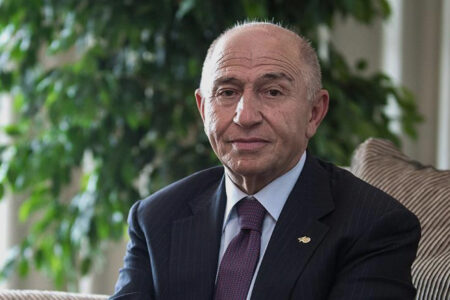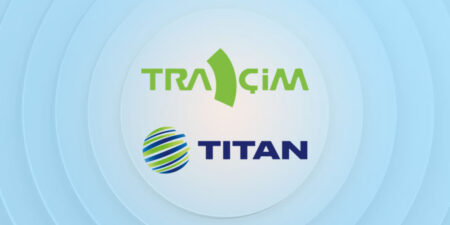INTERCEM, one of the leading international conferences of the cement industry, is being held in Istanbul for the 10th time this year. Organized in collaboration with the Cement, Glass, Ceramics and Soil Products Exporters’ Association (ÇCSİB), the event was opened by INTERCEM CEO Malcolm Shelbourne and ÇCSİB Vice Chairman of the Board Abdulhamit Akçay. Celebrating its 40th anniversary this year, the Istanbul edition of INTERCEM welcomed more than 500 senior industry representatives from over 50 countries.
“Expectations and realities contradict each other in the global environment”
Starting his speech with an assessment of global developments affecting the sector, Akçay stated, “The recent period has been marked by a contradiction between expectations and realities. As we transitioned from 2024 to 2025, forecasts about the U.S. elections and the end of wars had created a positive atmosphere in global markets. However, the fluctuations in geopolitical tensions—sometimes easing and sometimes escalating—cast a shadow over this optimism. Added to this were trade wars and aggressive tariff debates, which triggered significant concerns in international markets. Although progress has been made in tariff negotiations and recession fears have eased to some extent, concerns over international trade have not completely disappeared. The first eight months of 2025 also unfolded under the shadow of these uncertainties. While domestic demand declined in the U.S., the world’s largest cement importer, China’s real estate-related problems brought its imports nearly to a standstill. In contrast, demand has been rising in West Africa, Latin America, and some European countries. Moreover, interest rate cuts in many economies have stimulated global demand. In short, while stagnation prevails on one side, demand growth on the other leads us to expect the global cement industry to close this year with a performance similar to last year. Perhaps a limited decline of around 1% may occur, but the geopolitical developments in the remainder of the year will be decisive.”
“Geopolitical developments increase Türkiye’s significance”
Despite global challenges, Akçay underlined the international achievements of the Turkish cement sector, “Türkiye is one of the leading countries in global cement exports. We account for more than half of exports from the Mediterranean region and 10% of total global cement exports. Our share in U.S. imports stands at 30%. In the first eight months of this year, we increased our exports to the U.S. by 13% in tonnage terms—despite a decline in U.S. imports. This success stems from tariff adjustments, geopolitical concerns, and Türkiye’s position as a reliable supplier. Rising demand in Africa, particularly in West Africa, and challenges faced by traditional suppliers such as Egypt, have once again strengthened Türkiye’s role as a key player. Thanks to our high capacity, we secured substantial spot sales. In Europe, inflation control and restoration projects in Italy gave momentum to our sector, while we also recorded growth in the UK, Greece, Serbia, and Romania. Furthermore, the Syrian market, currently undergoing post-war reconstruction, along with strategic trade routes such as the Zangezur Corridor and the Iraq-Türkiye Development Road project, are further enhancing Türkiye’s regional importance. In short, despite ongoing global uncertainties, the Turkish cement sector continues to stand out with its capacity, strong logistics infrastructure, reliability, competitiveness, and uninterrupted service performance.”
“Our commitment to contracts strengthens our credibility”
Addressing the increase in spot demand, particularly from Africa, Akçay emphasized: “Indeed, we could have achieved much higher export figures through spot sales. However, we are a reliable supplier committed to our contracts. Within the framework of our long-term agreements, we plan our production and supply chain accordingly. Therefore, even when spot prices rose, we did not deviate from our obligations. This approach is the most tangible demonstration of why Türkiye is regarded as one of the most reliable players in the global cement industry.”
“The exchange rate must be determined by free market conditions”
Akçay noted that while the Turkish cement industry’s export revenue stood at USD 1.1 billion in 2024, they aim to increase this by over 18% to USD 1.3 billion by the end of 2025; in tonnage, from 19.1 million tons to over 23 million tons, marking a rise of more than 20%. Highlighting the 22% increase in tonnage-based exports achieved in the first eight months of the year as a strong indicator of meeting year-end targets, he continued:
“Despite this success, one of our major issues is profitability. While our TL-based costs have been rising at or even above inflation, the weak dollar exchange rate negatively impacts export-oriented sectors like ours. Our greatest expectation is for the exchange rate to be determined by free market conditions. Otherwise, this picture is not sustainable.”
“We are offsetting domestic contraction through exports”
On the domestic market outlook, Akçay stated:
“Although reconstruction efforts in the earthquake-hit regions are supporting domestic demand, contractions in many other areas limited growth to only 2% in the first five months of the year. However, we are compensating for these declines with exports, thereby maintaining balance in our sector and sustaining strong performance.”
“We expect 10% growth in 2026”
Sharing projections for the global and Turkish cement industries for 2026, Akçay said:
“Next year, we expect favorable macroeconomic developments to reflect positively on the sector. Anticipated interest rate cuts in the U.S. will ease conditions in construction and housing. While not a dramatic surge, we foresee a positive consumption trend in the U.S. market. This stability will serve as an important indicator for global cement trade. Furthermore, with the U.S. dollar expected to weaken, other commodities appreciating against the dollar will likely drive-up clinker and cement prices globally and in Türkiye. Indeed, this year spot sales saw a 30% increase in clinker and a 20% increase in cement. Geopolitical risks, market dynamics, and supply chain challenges continue to exert upward pressure on prices, and this trend is likely to persist. As for Türkiye’s 2026 export performance, we are highly optimistic. With rising demand in Africa, economic recovery in Europe, and stability in the U.S., we expect around 10% growth in Turkish exports.”
“We focus on green transition, energy efficiency, and digitalization as much as profitability”
Akçay concluded by highlighting sustainability and transformation priorities, “In addition to profitability, our sector is equally focused on green transition, energy efficiency, and digitalization. We are preparing for the Carbon Border Adjustment Mechanism, which will be gradually implemented as of 2026. At the same time, we aim to increase efficiency by integrating artificial intelligence and digital technologies into our production and quality processes. Despite global uncertainties and domestic challenges, the Turkish cement sector will continue contributing to the national economy with its strong production capacity, employment, and vision for transformation, while consolidating its critical role in the global supply chain.”
Following his speech, Akçay delivered a presentation titled “Past and Future Analysis of Turkish Cement Industry”, providing participants with detailed insights into the sector.
At the conference, where ÇCSİB participated under the Turkish Cement brand, topics such as market trends, capacity changes, logistics challenges, reliable supply chains, growth strategies for 2026 and beyond, decarbonization, new technologies, and digital solutions are also being discussed.





